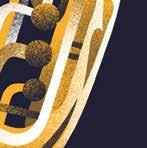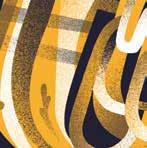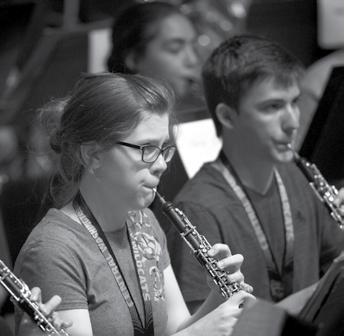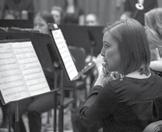MUSIC EDUCATOR







Spring 2018























A Lifetime of Service and Achievement


6 Tom Muller National Music Standards and Teaching Right-Hand Playing Techniques to Bowed String Instruments Students
10 Dijana Ihas Building A Strong Elementary Music Program













14 Janet Lea








Table of Contents Volume LXIX #2 May 2018 A Message From Our President Todd Zimbelman OMEA Future Projects Kathy Briggs A Lifetime of Service and Achievement Tom Muller Advocacy Committee Jennifer Mohr Colett 2019 OMEA All-State and Mega Conference Update Janet Lea National Music Standards and Teaching Right-Hand Playing Techniques to Bowed String Instruments Students for Conceptual Understanding Dijana Ihas Building A Strong Elementary Music Program Janet Lea Jazz Column Dan Davey 4 5 6 8 9 10 14 19 Advertiser Index Oregon State University Metropolitan Youth Symphony Central Washington University Soundwaves NAfME Corban University University of Portland Portland State University Whitworth University Northwest Band Camps Pacific University University of Oregon IFC 1 3 4 9 9 15 16 18 20 IBC BC Audition in June or by Appointment Tickets and Enrollment at www.playmys.org or 503-239-4566 June 3rd • Season Finale: Titan Mahler: Symphony No. 1 , Titan Concerto Competition Winners Also featuring performances by Symphonic Band 7:30pm at the Arlene Schnitzer Concert Hall 2017-2018 Downtown Series | Symphony Orchestra
Music Makers
EXECUTIVE BOARD
OMEA President
Todd Zimbelman West Salem High School rrtz@comcast.net
OMEA President Elect
Kathy Briggs Saint Mary’s Academy kathy.briggs@smapdx.org
OMEA 2nd Vice President
Janet Lea North Bay Elementary jlea@nbend.k12.or.us
OMEA Past President
Tom Muller David Douglas High School tom_muller@ddsd40.org
OMEA Treasurer David Becker Retired/Lewis and Clark dbecker@lclark.edu
OMEA Executive Director
Carolyn Sutton South Middle School oregonmusicdirector@gmail. com
AREA CHAIRS
Advocacy Co-Chair
Jennifer Mohr Colett Fir Grove Elementary oregonmusicadvocacy@gmail. com
Advocacy Co-Chair
Andie Andeen Salem-Keizer Andeen_andie@salkeiz.k12. or.us
Band Chair
Jeff- Hornick Oregon Episcopal School jhandbh@mac.com
Choral Chair
Karen Bohart Reynolds High School kbohart@rsd7.net
Orchestra Chair Dijana Ihas Pacific University dihas@pacificu.edu
Jazz Chair Dan Davey Mt. Hood Community College daniel.davey@mhcc.edu
Elementary Chair Beth Wheeler University of Oregon bethw@uoregon.edu
General Music Chair Mari Schay Earl Boyles Elementary mari_schay@ddsd40.org
SMTE Chair Sandra Babb Oregon State University Sandra.babb@oregonstate.edu
Business/Sustaining Member Chair Rob McGlothin Sandy HS robert.mcglothin@ortrail.k12. or.us
Membership Chair Stephen Fulks Stayton HS & MS stephen.fulks@nsantiam.k12. or.us
Small Ensemble Contest Chair Dan Judd Summit High School dan.judd@bend.k12.or.us
State Solo Contest Chair Tom Muller David Douglas HS tom_muller@ddsd40.org
DISTRICT CHAIRS
District 01 Chair Gary Riler Cleveland High School griler@pps.net
District 02 Chair
Rob McGlothin Sandy High School robert.mcglothin@ortrail.k12. or.us
District 03 Chair
Michael McClure Warrenton Grade School mcclurem@warrentonk12.org
District 04 Chair
Deborah Barber
Orchestra Salem-Keizer SD barber_deborah@salkeiz.k12. or.us
District 05 Chair
Ben Lawson Redmond High School ben.lawson@redmondschools. org
District 06 Co- Chair
Andy Cary Pendleton HS / Sunridge MS Andrew.cary@pendleton. k12.or.us
District 06 Co- Chair
Emily Callender Sundridge Middle School emily.callender@pendleton. k12.or.us
District 0 7 Chair
Chris Rowbotham Siuslaw Middle and High School crowbotham@siuslaw.k12.or.us
District 08 Co-Chair
Steve Kessler North Medford High School steve.kessler@medford.k12. or.us
District 08 Co-Chair
Kendra Taylor North Medford High School kendra.taylor@medford.k12. or.us
District 09 Chair
Max Thew Nyssa High School mthew@nyssa.k12.or.us
OMEA Sustaining Members 2018
Action Fundraising
Kim Allen kim@actionfr.com PO Box 1281 Sherwood, OR 97140 actionfr.com
Beacock Music
Russ Beacock
Phil Hodapp philiphodapp@gmail.com
Educational Travel Services
Julie Sabala julie@etsi.ws www.etsi.ws
J.W. Pepper & Son, Inc.
Brad Mastrangelo bmastran@jwpepper.com www.jwpepper.com
Metropolitan Youth Symphony
Diana Scoggins dscoggins@playmys.org www.playmys.org
Northwest Band Camps, Inc
Larry Hine larry@nwbandcamps.com www.nwbandcamps.com
Oregon State University
School of Arts & Communication
Zachary Person zachary.person@oregonstate.edu
101 Benton Hall Corvallis, OR 97331 liberalarts.oregonstate.edu/ music
District 10 Chair
Karalyn Soffer Riddle School District karalyn.aprill@gmail.com
District 11 Chair
Danny Mitchell Timber Ridge School daniel.mitchell@albany.k12. or.us
District 12 Chair
Tim Vian Thurston HS tim@vianfamily.com
District 13 Chair
John Donnelly LaSalle High School jdonnelly@lsprep.org
District 14 Chair
Laura Arthur Athey Creek Middle School arthurl@wlwv.k12.or.us
District 15 Chair
Mandy Burton Highland Park MS Mandy_Burton@beaverton. k12.or.us
SPECIAL BOARD REPS/LIAISONS
OSAA Band / Orchestra Contest Chair
Chuck Bolton Retired tubasat@aol.com
OSAA Band Rep
Jeremy Zander Mountainside HS Jeremy_Zander@beaverton. k12.or.us
OSAA Choral Liaison
Kimberly McConnell West Salem High School mcconnell_kimberly@salkeiz. k12.or.us
OSAA Choir Contest Chair Matthew Strauser Retired oregonacda@gmail.com
OMEA Historian David Becker Lewis and Clark College, Retired dbecker@lclark.edu
Journal Editor Chair Jason Silveira University of Oregon jsilveir@uoregon.edu
Journal Editor Tina Bull OSU, Retired tinamariebull@gmail.com
OMEA Recording Secretary Laura Arthur Athey Creek Middle School arthurl@wlwv.k12.or.us
NW NAfME Regional President John Combs jcombs@mcps.k12.mt.us
NW NAfME Regional President Camille Blackburn NAfME queencamille@gmail.com
PUBLISHING & PRINTING
Cover Art & Journal Design Aren Vandenburgh arenv.com
Printing & Mailing Shelton Turnbull 3403 W 7th Ave Eugene, OR 97402 stprint.com
Portland State University
School of Music
Debbie Glaze glazed@pdx.edu www.pdx.edu/music
Quaver Music.com
Alayna Anderson alayna@quavermusic.com www.QuaverMusic.com/ preview
University of Idaho
Lionel Hampton School of Music
Spencer Martin spmartin@uidaho.edu https://www.uidaho.edu/class/ music/
University of Oregon School of Music
Sara Spicer SOMDadmit@uoregon.edu Eugene, OR music.uoregon.edu
University of Portland – PFA
Dept.
David De Lyser 5000 N. Willamette Blvd. Portland, Oregon 97203 up.edu/music
Wally’s Music Steve Bond steve@wallysmusic.com
Western Oregon University James Nail naili@wou.edu Monmouth, OR
Willamette Valley Music Co. Charles Kem Kemtone@wvmc.net www.wvmc.net
Yamaha Corporation of America Band & Orchestra Division
Josh Prewett jprewett@yamaha.com 11410 NE 124th St PMB 521 Kirkland, WA 97034
2 Oregon Music Educator • Volume LXIX #2 May 2018 • Spring 2018














cwu.edu/music Band Camp Drum Major/ Leadership Academy JULY 8-12 JULY 8-12 CWU is an EEO/AA/Title IX Institution. For accommodation email DS@cwu.edu 17-Music-0061-BA CWU Music Department @CWU_Music @CWU_Music @CWU_Music FOR MORE INFORMATION, OR TO REGISTER FOR A CAMP, VISIT: Jazz Camp JULY 22-28 CHRIS BRUYA, Director LEWIS NORFLEET, Director LEWIS NORFLEET, Director IT’S A SUMMER THAT CAN LAST A LIFETIME 2018 CWU MUSIC CAMPS ARE ABOUT MORE THAN MUSIC. THEY’RE ABOUT LEADERSHIP, DEDICATION, AND DISCOVERY. THEY’RE ABOUT LEARNING TO PERFORM AT A HIGHER LEVEL. FOR ALL MUSIC STUDENTS ENTERING GRADES 9-12 SUMMER
A Message From Our President
Todd Zimbelman OMEA President

I hope everyone is having an outstanding spring. Thank you for attending the OMEA 2018 Conference and encouraging your students to participate in one of the All-State Honor Ensembles. Congratulations to Kathy Briggs and the Conference Planning Committee for running a successful and meaningful conference. Janet Lea will be in charge of the 2019 OMEA conference. In 2019, we will be running the OMEA All-State Ensembles on the same weekend as the All-Northwest conference in Portland. For any questions regarding the 2019 conference, updates, and deadlines, please visit the OMEA website or email Janet Lea (jlea@ nbend.k12.or.us).
OMEA Communication
Please contact me if you have any ideas for OMEA. I will take them to the OMEA board and represent everyone to the best of my ability. Please visit the website regularly. This is an incredible tool for calendar planning, policies and procedures, updates, and sharing information. Make sure your membership information is up to date as well. This is critical for us to reach you through email and regular mail. I will be moving into the Past-President position after the May board meeting and Kathy Briggs will be your new president. Her leadership style is fantastic, and she will move the organization forward to new heights. Please email her any new ideas you have for the future (kathy.briggs@smapdx.org).

From The Band Room BALANCE! What is balance really? Is the “pyramid of sound” the only way to approach wind ensemble music? I follow some simple guidelines regarding balance.
1. Stay true to the intent of the composer and their desired sound intensities. Avoid playing the music of Mason Bates with the desired sound of Francis McBeth. This may mean changing your dynamic scope, approach to balance, and developing extended skill sets.
2. Make sure the melody or main idea is always heard.
3. Always play with a quality sound.
4. Bring out the moving lines.
5. When playing homophonic music, listen back and down for good blend and balance.
6. Even when balancing with/to others, play with a characteristic sound. A piccolo should not sound like a straw flute.
7. Say something and communicate with intent. Every line can be expressed with meaning, no matter if it’s the melody or not. Too often when bands apply the pyramid of sound to every style of music, the intent is missing, and diverse styles sound similar.
8. Adjust the orchestration for lines that are over doubled or have too many students on one part. You will be amazed at the dynamic range and expressive qualities when you make a certain phrase truly one on a part. Add more players, then add everyone, etc. Your dynamic range and ability to balance will improve greatly.
There are others, but I think you get the idea. Make music, stay true to the composer, say something, use the most dramatic range of dynamics you can perform with a quality sound, and use the best balance possible without sacrificing the intent of the music.
4 Oregon Music Educator • Volume LXIX #2 May 2018 • Spring 2018
OMEA Future Projects
Kathy Briggs OMEA President-Elect

My term as President-elect is soon transitioning, and I am preparing to follow in Todd Zimbelman’s footsteps as our next OMEA president. As I look to the future of OMEA, I am contemplating many aspects of our organization and how it can best serve our state’s music teachers and students. We are in a unique position of not having a state conference in 2019 which affords us the opportunity not only to reflect on what went well at this year’s conference along with what can be improved, but also a timeline that provides us an interlude to make necessary changes. I look forward to working with our new President-elect, Jeremy Zander, on some of these changes and improvements. Most importantly, I would love to hear from you regarding what some of your focuses might be for the future of OMEA and how we as an organization can best serve you, our schools, and our music students. Here are some of my current thoughts for future projects.
Music Advocacy Coalition
I am interested in researching the possibilities of a coalition between our active and engaged OMEA Advocacy Team and other groups in the state, such as OBDA, ACDA, ASTA, OAKE, and other parent music booster organizations. Coalitions speak the loudest to elected officials. Requesting funds for music education is fruitless when there is hardly any education budget at all. When working with a crippled state education budget (not just music education, but education in general) we need to work in tandem with other state education associations, such as NEA, AFTA, OEA, etc. Creating a strategic vision which several of our like-minded advocacy groups can endorse is powerful. I know that members of our OMEA Advocacy Team have joined OEA for their advocacy day in Salem in the past. While attending the NAfME National Assembly last summer in Washington, DC I spoke with other states’ leadership and learned about the strength of their advocacy efforts when working together with other state education grass-roots lobbying efforts and music advocates. Our advocacy team has been doing important work, most recently with TSPC. Our statements and our efforts may be further strengthened if we work in tandem with other state organizations.
Collegiate NAfME Involvement & Programming
I hope to explore possibilities to further engage and serve our collegiate members. WMEA (Washington) was honored at
the national level for fantastic collegiate programs, including a mini-conference and new teacher workshops specifically for their collegiate members. I would love to have our OMEA college students work together to create such opportunities here in Oregon. At the national assembly last summer, I was disappointed that Oregon was one of the few states that had no collegiate representatives attend or join us as we advocated with our elected officials during “Hill Day.” I am interested in looking into the possibilities of scholarships through OMEA and our state’s universities to make this happen for our future music educators.
OSAA Choral Contest
There has been a growing concern regarding transparency and how the contest is run. Through ongoing discussions with the leadership in ACDA, OMEA, and OSAA I hope to continue the conversation and bring about change that provides clarity and consistency regarding how the contest is managed, scheduled, and scored so that all students, conductors, contest managers, and adjudicators understand the expectations and educational purpose of the event.
OMEA State Conference and All-State Planning Team
I plan to look at other state organizations’ planning structures, leadership positions and roles, and timelines. We have strong leadership and a great conference planning team, but as our conference and our all-state ensembles grow, we need to examine if our infrastructure and personnel are able to keep up with the demand. We also need to ensure that protocols are in place to ensure a smooth transition for the organization when there is change in leadership.
I hope to hear your thoughts on these topics and look forward to continuing to serve you, our music students, and our organization.
5 Oregon Music Education Association • 560 A NE F St PMB 732; Grants Pass, OR 97526 • 541.291.1149 • oregonmusic.org
A Lifetime of Service and Achievement
Tom Muller Past President
“Just do whatever Jane says. She knows everything.” “It’s your conference.” These are two sentences most conference chairs heard at some point, and truer words were never spoken. Jim and Jane Howell (as most of you know) retired from OMEA in 2017, and we could not let them go without saying goodbye. The Executive Board has awarded the Howells a Lifetime Achievement Award for their years of dedication to the Oregon Music Education Association. Because they were unable to attend All-State this year, I wanted to express my gratitude in writing.
Much of their work was behind the scenes, but was felt by every OMEA member, Oregon students, and parents. Their tireless efforts with the development of every conference impacted everyone, though much of it was not seen. Their efforts, coupled with their dedication to the business of running OMEA, has left an indelible mark on us all.
As a member of the Executive Board, one works very closely with the Executive Directors one’s entire term. First as President-elect, the Executive Directors help in developing and organizing your conference. Next as President, where one works with them as one leads OMEA, and finally as Past-president in helping the transition from one president to the next. The Executive Director of OMEA is the only constant within the association. They are the ones who help with advising the new leadership every two years.
During my time on the Executive Board, the incredible relationship I developed with Jim and Jane will always stay with me. They were able to help me with finding the vision I had for my conference. At times, they knew the questions I had before I did! Through it all, they allowed me to organize “my conference,” as Jim would remind me. “Just do what Jane says” was the best advice I received, and I made sure to pass it on the future conference chairs. I appreciated their guidance as president, and was very grateful for it when issues arose. I found their commitment to OMEA inspiring, and I worked to continuously earn their respect. Watching their honest, and unwavering commitment to Oregon teachers, student, and parents has had an impact that many do not know. I am honored to have known them, and will always consider them to be good friends. I truly missed seeing them at All-State this year.
in LaGrande. He served as OMEA treasurer, and eventually became [an] administrator of OMEA. During their time as Executive Directors, they helped to reinvent the website, streamline the Policies and Procedures, and brought new levels of organization and structure to OMEA.

Jane emits a warmth that makes you feel loved and welcomed, and well taken care of. I have also witnessed her quickly “cut to the chase,” and let anybody, and anyone not holding up their end of the bargain know who is in charge! She is the epitome of a strong, intelligent woman who knows how to get the job done. I wish her and Jim all the best in their new chapter.
To me, Jim and Jane Howell exemplify what it means to serve. During their tenure with OMEA, they gave their absolute all to the betterment of the organization. Never has the nuts and bolts, and behind the scenes work been smoother, nor more thorough. Jim and Jane have great minds and hearts. They always had an answer, and when that answer was not readily available, they worked hard to figure it out. They truly cared for music education in Oregon, and worked hard to make sure the music educators were provided with the best to make quality music education possible. I love them both, and missed their presence at this year’s conference.
I first got to know Jim when I joined the Executive Board, and Jim was President. He was so thoughtful, committed, and absolutely devoted to the process. I remember him asking my opinion at the first meeting and was so impressed by his desire to include “the new guy.” I learned quickly that his attention to the process, his devotion to service, and his concern for every person was a hallmark. Later, I met Jane, and what a perfect couple they were. When we had the chance to make them co-Executive directors of OMEA, it was clear that we had truly “scored,” bringing passion, devotion, and a true love for music in our state.
Jim and Jane Howell have provided decades of service to music education in the state of Oregon. Before becoming administrators of OMEA, Jim was also an exemplary teacher
Jim and Jane Howell truly exemplify the heart of OMEA leadership. My long friendship with the Howells spans from the 1990s to present day. Jim brought his volunteer spirit of service to the OMEA Board as Treasurer for decades, serving numerous OMEA Presidents and countless OMEA conferences. When Jim and Jane were selected as coExecutive Directors, they engendered a confidence and joy in their continued involvement in an organization they loved to serve. Jane’s experience in non-profit work and
6 Oregon Music Educator • Volume LXIX #2 May 2018 • Spring 2018
I am not the only one who shares these same feelings, however. Other Executives, and PastPresidents wanted to make sure the Howells knew how they felt:
Jim’s long history with the organization as a practicing music educator and board member were essential elements in their administrative success. They committed to network and grow professionally as they attended national meetings and training. I was fortunate to spend many National Assemblies with Jim and Jane in Washington DC, as they so ably represented Oregon on the national scene of music administrators. I can’t begin to adequately thank Jim and Jane for the decades of friendship, service, and selfless dedication to OMEA and to all of us whom they helped. They accomplished all of this with grace, patience, humor, and consummate professionalism. On behalf of the thousands of teachers and student who have benefited from their service, I can only say, “Thanks friend, for the work and the memories. It’s been a great ride.”
Jim and Jane Howell have been dedicated stewards of OMEA for years as co-Executive Directors. When the Howells were hired by OMEA, Jim brought with him a wealth of experience as an award-winning band director, and a successful tenure as OMEA President. Jane brought with her an extensive experience as a non-profit arts group organizer. Jim and Jane have been tireless in their steadfast stewardship of OMEA, consistently looking out for the best interests of the organization and its members. Treating their part-time OMEA job as a more than full-time job, Jim and Jane have always gone above and beyond their job description and thus have made a massive contribution to the success of the organization.
I can attest [that] Jane and Jim Howell gave their hearts and souls to the organization. Jane thoughtfully approached every problem and sought solutions that were for the great[er] good. Jim meticulously cared for our finances, demonstrating his pledge to be an honorable steward for our non-profit organization. Both Jane and Jim worked thoughtfully and kindly with students, parents, teachers, and board members. They brought smiles and loving
concerns for the well-being of those around them. In spite of working long days and nights and driving hundreds of miles to attend our events, the Howells always arrived with positive energy, devotion, and dedication to OMEA. They exemplified the qualities we all strive for:
1. Show compassion for others.
2. Listen carefully.
3. Work hard.
4. Share joy.
5. Make the world a better place for having lived in it. Jane and Jim Howell have lived their lives exactly this way.

I am so pleased the OMEA Executive Board is awarding Jim and Jane Howell a special Lifetime Achievement Award to celebrate and reflect their years of involvement to the arts and education. This award is specifically a thank you for the phenomenal work they have done in the service to OMEA in their roles as co-Executive Directors for the past decade. Jim’s stellar career as a beginning teacher in Condon, and later at the helm of the La Grande High School band program confirmed his wonderful potential. His program was highly regarded for its creativity, innovation and comprehensive approach to music education, while still maintaining high performance standards.
We both served on the OMEA board as the organization faced some challenging years. During Jim’s years at Treasurer, his diligent work enabled the organization to get back on its feet financially. His subsequent Presidency was one of the best we have had during my involvement with the board. His insight and ideas, all presented in his calm, gentlemanly manner, helped to shape the association.
I met Jane through her work with the Oregon Alliance for Arts Education (OAAE) and was immediately impressed by her background and passion for the arts and arts education. She was a most impressive board member and had the utmost respect of everyone who knew her professionally. The unexpected outcome that ultimately would benefit OMEA came from Jim and Jane meeting through their work with the OAAE.
After their marriage, Jane transferred her work to serve counties in Northeastern Oregon, while Jim continued his service to OMEA. Through their vision to better serve gifted and serious music students’ needs in the region, they started a non-profit music camp at Wallowa Lake. This extremely successful camp continues on today, drawing students from much of Oregon and Washington.
Beginning in 2009, Jim and Jane began sharing the position as OMEA’s Executive Directors. Their hard
7 Oregon Music Education Association • 560 A NE F St PMB 732; Grants Pass, OR 97526 • 541.291.1149 • oregonmusic.org
Jane and Jim Howell
work, good judgment and combination of skills, coupled with their passion and commitment to arts education have moved OMEA forward in so many tangible ways. Plus, their tremendous people skills and gracious approach to leadership have made great strides in building community among our hundreds of members from all corners of the state. Their accomplishments and impact have been unprecedented, certainly in OMEA’s recent history.
So, even though both have previously received recognition through OMEA’s “traditional” annual awards (Jim for Outstanding Music Educator, and Jane and Jim for Exemplary Service Award), the OMEA presents this unprecedented
Advocacy Committee
Jennifer Mohr Colett Advocacy Co-Chair

Music advocacy work in Oregon continues to develop. Since our last Journal update, Andie Andeen, Music Program Assistant for the Salem-Keizer School District, has stepped up to serve as Advocacy Co-chair with me. She and I are teaming up to manage the work of leading the Advocacy Committee, arranging advocacy sessions at conference, following policy issues at the state level, and coordinating with regional and national levels of NAfME.
It has been two years now since OMEA completed a first round of data collection for the Oregon Student Music Access Project (OSMAP). The information gained from the project has been useful on many levels, but it was also extremely labor-intensive. We are strategizing about how to make the project sustainable so data remains relevant. Andie has developed a Google Form for OSMAP data and it is being piloted in Salem. Our goal is to refine the tool to make it ready for another statewide sweep.
The Advocacy Committee met in Eugene during State Conference and identified goals for the coming year. We are working with NAfME President Elect, John Combs, to shape Advocacy sessions for NAfME NW next year. We are also beginning a full update cycle for OMEA’s Program Standards for Music Education in Oregon Public Schools. The last update in 2016 focused on surface-level changes (names and citations) and had a shorter timeline. This update will be more thorough to ensure the document aligns with the 2014 NAfME Opportunity-to-Learn Standards. A new subcommittee has formed to initiate proposed changes to the Advocacy Committee, which will then review and approve the proposal to share with the OMEA State Board this spring. The State Board will take time to share the proposal with their constituents in district meetings and bring further recommendations to the Fall Board meeting. A final version is expected for Board approval in February 2019. If you would like to participate in the subcommittee or Advocacy Committee, please write to oregonmusicadvocacy.org.
Congratulations and many thanks to OMEA President Elect, Kathy Briggs, and the entire Conference team for a successful State
Lifetime Achievement Award with our sincerest gratitude and best wishes for a long and happy actual retirement.
It is plain to see that Jim and Jane Howell have had an enormous impact, not only on the Oregon Music Education Association, but also on hundreds (if not thousands) of teachers, students, and their parents. A simple thank you cannot come close to expressing our gratitude. I also want to thank Dave Becker, Kathy Briggs, Tina Bull, Debbie Glaze, Christopher Silva, Pat Vandehey, Steve Zielke, and Todd Zimbelman for their contributions to this article.
Conference. Good memories and a healthy amount of follow-up are still flowing from that event.
At the national level, I continue to attend NAfME Advocacy Leadership Force webinars each month. These talks are valuable for keeping up-to-date with the latest information on ESSA and other Federal budget and policy news.
Unfortunately, in Oregon we have little hope for ESSA funding changing anything for music. There are two reasons for this: (1) The recent federal budget is the biggest fiscal package in a decade. The total dollar amount for spending is known, but we don’t yet know how it splits out to education. We are awaiting an omnibus appropriations bill. And, (2) President Trump’s FY 2019 budget once again suggests zero for Title IVa and Title II; it also effectively reduces Title I a bit (and includes fund portability for private schools). This budget has not yet been adopted and may shape NAfME Hill Day advocacy again like last year.
NAfME is working to influence Higher Education Act reauthorization. They are asking to align teacher prep with ESSA, promote diversity and cultural responsiveness in music education, and to allow loan forgiveness for well-rounded subjects. (Such funding has traditionally gone to math and science.) An infrastructure proposal is being considered by congress; unfortunately, there is no targeted funding for schools. On the bright side, however, the GAAME act is exciting and new! It stands for “Guarantee Access to the Arts and Music Education.” NAfME is working with a sponsor for this bill. It’s a long-term goal and would be added to Title 1 in ESSA, perhaps next year or whenever ESSA is reauthorized.
8 Oregon Music Educator • Volume LXIX #2 May 2018 • Spring 2018
2019 OMEA All-State and Mega Conference Update
Janet Lea OMEA 2nd Vice President

A reminder to you all that the conference will be in conjunction with All-Northwest at the Oregon Convention Center in Portland on February 14–17, 2019. Look for a detailed update in our Fall 2018 Journal. Here is a simple outline of where our OMEA All-State Ensembles will be performing. Exact performance times are to be determined, and should be similar to our normal routine.

• High School Wind Ensemble, High School Large Strings Ensemble, and High School Mixed Choir to perform at the Oregon Convention Center. The All-Northwest and WMEA All-State High School groups will also be performing there.

• Middle School Band and Middle School Orchestra will perform at Franklin High School in SE Portland. Thank you to Jason Owens.
• Middle School Mixed Choir and our Elementary Choir will perform at First United Methodist Church in SW Portland.
All OMEA students will be housed in SW Portland within a ½-mile radius of each other and just across the river from the Oregon Convention Center. More details to come in the fall on where teachers/conference attendees can stay.
This conference will be fantastic. The headliner is Larry Livingston from the University of Southern California Thornton School of Music. Look him up if you get a chance. I’m so excited to see you all there!
National Music Standards
and Teaching Right-Hand Playing Techniques to Bowed String Instruments Students for Conceptual Understanding
Dijana Ihas, Ph.D.
 OMEA Orchestra Chair, Associate Professor, Pacific University
OMEA Orchestra Chair, Associate Professor, Pacific University
The main difference between the 2014 National Music Standards (NAfME, 2014) and 1994 National Music Standards (MENC, 1994) is that new standards place more emphasis on musical literacy and conceptual understanding, while the old standards emphasized knowledge and skills. For example, while both sets of standards identify “performing” as one of the standards or artistic processes in which music students need to be engaged, in the anchor standard category labeled “Select” under the second artistic process named “Performing,” the 2014 standards suggest that when selecting a piece of music, students should be able to “understand their own technical skills” (NAfME, 2014), while the 1994 standards suggest that students should be able to perform “on instruments, alone and with others, a varied repertoire of music” (MENC, 1994). An informal overview of current string method books (Ihas, 2017), reveal that teaching strategies proposed in these books emphasize teaching basic knowledge and skills over musical literacy and conceptual understanding (probably because most of them were written during the time of old music standards) leaving teachers and students to figure out their own ways towards a fulfillment of the new recommendations. The purpose of this article is to provide readers with insights into teaching for conceptual understanding, while teaching string orchestra students right-hand playing techniques that are commonly used is school orchestra literature.
Conceptual Understanding Explained
In the Taxonomy of Educational Objectives, Bloom (1956) placed understanding or comprehension at the second lowest level of thinking hierarchy, right after the most basic level of thinking that is knowing. In the appendix to this seminal work, Bloom explained comprehension as type of “understanding or apprehension such that the individual knows what has been communicated and can make use of material or ideas being communicated without necessarily relating it to other material or seeing its fullest implications” (p. 203).
Constructivist theory of learning expanded the meaning of understanding from the basic ability to classify, describe, and explain to the ability to use and transfer knowledge to new learning and life situations. This happens through a process of evolving basic knowledge into meaningful knowledge that is characterized by conceptual understanding.
Ausbel (1963) was an educational psychologist and pioneer in studying meaningful learning and conceptual understanding. He proposed that in order for the learner to attain conceptual understanding, new knowledge must be subsumed under a broader, more inclusive, superordinate knowledge. For example, the learner will have an easier time to grasp the concept of the poetic form “sonnet” if the learner can position this newly attained knowledge within a broader and more inclusive concept of “poems” to which sonnet is just one of the many forms. Further, the learner will deepen his or her knowledge and understanding by linking it with another type of broad, but less inclusive knowledge, coordinate knowledge. Many thinking processes, including comparing and contrasting, can aid the learner in the attainment of coordinate knowledge. To follow up with an example of gaining the conceptual understanding of “sonnet,” a coordinate level of understanding would take place when the learner compares sonnet with other types of poetic forms and grasps both, the generalizable and unique characteristics of sonnet form. The final stage in attaining conceptual understanding, subordinate knowledge, is when the learner understands the particular properties of the matter at hand. That is when the learner is able to write a sonnet based on attained conceptual understanding of the form through reference to subordinate and coordinate levels of knowledge.
Making appropriate links with other types of knowledge, such as experiential knowledge, analogic, causal, and procedural knowledge can also contribute to a meaningful learning and conceptual understanding. It appears that it is exposing learners to a variety of kinds of relevant knowledge and teaching them to make connections between newly attained knowledge and the broader and more inclusive, but related categories of knowledge, what leads to conceptual understanding.
Application of Principles of Conceptual Understanding
When principles of constructivists learning theory, as proposed by Ausbel (1963), are applied to the new national music standards, it appears that music teachers should not only teach students to execute certain playing techniques by rote, but that teachers should also teach students to understand these techniques in the contexts of larger and more inclusive categories of knowledge. These may include things such as right-hand and left-hand playing techniques (superordinate levels of knowledge). To further deepen students’ conceptual understanding of their own playing techniques, students should then learn that, for example, righthand playing techniques are organized in categories such as
10 Oregon Music Educator • Volume LXIX #2 May 2018 • Spring 2018
“Give a man a fish and you feed him for a day. Teach him how to fish and you feed him for a lifetime.”
- Lao Tzu (died 531 A.D.)
bow strokes, bowing patterns, and elements of tone production (coordinate level of knowledge). Finally, students should learn the particulars of each individual right-hand playing category such as martelé. This is a short, hammered bow stroke, usually played in the upper middle part of the bow with the pressure (weight) being applied at the beginning of each bow movement and immediately released during the bow travel from the beginning of the note to its end (subordinate knowledge). Students should learn this along with experiencing this bow stroke while playing technical exercises and in the repertoire.
Right-Hand Playing Techniques: Superordinate Level of Knowledge
Varied string methods and approaches have different views on the role of right-hand techniques in playing string instruments. For example, Galamian (1985) suggested that it is the right-hand that interprets the music on bowed string instruments. On the other hand, Havas (2003) advocated that it is the left-hand that interprets the music and that right-hand just follows what left-hand dictates. For the purpose of this article, we will adopt Galamian’s statement: “To understand the function of the bow, one has to realize from the very onset that the whole right arm technique is based on a system on springs.” (Galamian, 1985, p. 44) as a guiding superordinate principle of right-hand techniques.
Right-Hand Playing Techniques: Coordinate Level of Knowledge
Galamian (1985) organized basic concepts of right-hand techniques in four categories: (a) fundamentals, (b) tone production, (c) bowing patterns and (d) special bowing problems. Applebaum (1986), on the other hand, organized right-hand techniques in three categories: (a) developing a fine bow arm, (b) the specific bowings and how to teach them, and (c) how to produce a beautiful tone. For the purpose of this article, we will propose following an adapted categorization of right-hand playing techniques that will serve as a coordinate principles of right-hand playing techniques: (a) bow Strokes, (b) bowing patterns and (c) tone production.
Bow Strokes - Subordinate Level of Knowledge
Bow strokes (bow styles or bow articulations) are the key components of expressive performance on bowed string instruments. For example, playing the same sixteenth notes passage with the bow hair on-string or off-string is going to dramatically change the aesthetic and emotional effect of the passage.
Several inherited difficulties that orchestra teachers and conductors need to be conscious of when it comes to teaching bow strokes for understanding are: (a) the terminology for bow strokes is limited and can be confusing, (b) orchestra scores often don’t include appropriate bow stroke articulations, and (c) there is a difference between how the same bow stroke is executed in a solo/chamber music setting versus an orchestra setting.
Varied string pedagogues have proposed various ways of organizing bow strokes. For example, Rolland (2010) proposed three types of bow strokes: (a) swinging, (b) pulling, and (c) pushing bow strokes. In his comprehensive guide to bowing techniques, Kjelland (2003), organized bow strokes into three groups: (a) on-the string, (b) offthe string and (c) onff-the String {sic} bow strokes. For the sake of simplicity of this article, bow strokes will be organized in three categories: (a) on-the string, (b) off-the string and (c) expressive bow strokes. Within these categories, only bow strokes that are in use in school orchestras will be examined in more detail.
Bow Strokes-Coordinate Level of Knowledge
On-the String Bow Strokes - One Note per Bow Direction
Détache (French for separate) is a single note per bow, smooth bow stroke with concealed bow changes, usually played in the upper part of the bow for violins and violas and in the middle part of the bow for cellos and double basses. There are three types of détache: (a) a simple détache that is played with an even and connected stroke and that usually has no specific articulation marking; (b) a détache lancé (also known as détache porte) that is played with slight separations between the notes and that is in some scores indicated with tenuto line and dot and (c) an accented détache that is played with connected bow movements but with additional weight on each note. This type of détache is usually marked either with a tenuto line or with a tenuto line and accent. Détache bowing is used in music of all periods but it is particularly characteristic of the Baroque Era.
Martelé (French for hammer) is a single note per bow, short and crisp bow stroke, usually played toward the tip of the bow for violins and violas and in the upper middle part of the bow for cellos and basses. The unique characteristic of this bow stroke is its energetic sound that is produced by the sudden release of the weight of the bow and right-arm at the moment when the bow is moved (weight applied > weight released at the moment of movement > bow stops > weight applied). Martelé is usually indicated by staccato dots but sometimes also with accents, wedges, combinations of three or with the term marcato. Martelé bowing is used in music of all periods and it is an extremely important pedagogical bow stroke to be taught to beginning students as a mean of teaching tone production.
On-the String Bow Strokes - Two or More Notes per Bow Direction
Group staccato (Italian for separated or discontinued) is a linked bowing of two or more even completely stopped notes in a single bow direction. The major difference between staccato and martelé is that in staccato there is no weight release as in martelé. Rather, the weight of the bow and right arm is continuously applied to the strings and is indicated by a staccato dot and slur. This bow stroke is used in all periods, even though its style may vary from distinctly articulated to very smooth, depending on the style of period and character of music.
Portato (Italian for to carry) or Loure is also a linked bowing of two or more notes in a single bow direction. Unlike in staccato, where the bow is completely stopped between notes, in portato, the bow
11 Oregon Music Education Association • 560 A NE F St PMB 732; Grants Pass, OR 97526 • 541.291.1149 • oregonmusic.org
is pulsating within a continuous tonal duration. This bow stroke is usually indicated by tenuto lines and the slur, but it can also be indicated by an accent mark and slur, depending on the period style and edition. Portato is used in slow movements and in piano dynamics in music of all periods, but its use is more typical of the Baroque Era.
Off-the String Bow Strokes - One Note per Bow Direction:
Spiccato (from Italian verb spiccare for separated) is a one note per bow crisp and bouncing stroke, executed by a controlled dropping and rebounding of the bow. There are three types of spiccato: (a) brush spiccato (also known as horizontal spiccato) that is played closer to balance point of the bow stick and with the bow that stays on the string for a longer time; (b) bounce spiccato (also known as vertical spiccato) that is played closer to the middle part of the bow stick and with the bow that stays on the string for a shorter time and (c) heavy spiccato (or marcato) that is played as hammered-off bow stroke in the frog part of the bow (e.g., the “faith motif” from Beethoven’s Fifth Symphony). Pedagogical views differ regarding whether the first note in these types of spiccato should start on or off the string, and teachers need to make this important decision for their students. Spiccato is indicated by dots and implied by the style and speed of the music. This bow stroke is most typical of Classical period, even though it is used in later periods as well.
Collé (French for glued or sticky) is a one note per bow – a short, sharply pinched bow stroke that is executed by right-hand fingers movements as they slightly lift the bow off the string in preparation for the next stroke. This bow stroke is usually played in the frog part of the bow, and while it begins on the string, it ends off the string. Its typical use is in repeated down bows, as in repeated chording or sforzando, as well as in the Classical motif (two slurred notes on down-bow followed by two separated but both up-bow eight notes). Collé is not indicated by any specific articulation markings but consecutive repeated down bows or up bows will suggest an application of this bow stroke.
Off-the String Bow Strokes - Two or More Notes per Bow Direction
Flying spiccato or Staccato Volante is a series of off-string bouncing notes in one direction, usually an up-bow direction. The bow movement is continuous and limited to the lower part of the bow. Besides staccato dots, no other special markings are used to indicate this bow stroke; it is the style and the speed of the passage that suggests its use.
Ricochet (French for rebound) or saltando or jete, is series of off string bouncing notes in one direction, usually a down-bow direction, followed by a single up-bow note. The stroke is caused by only one impulse in the right-arm. It is played in upper two-thirds of the bow with stick directly above the hair (no tilt). Ricochet is marked by staccato dots and a connecting slur on down-bow.
Expressive Bow Strokes:
Con Legno (Italian for with wood) is a bow stroke played by the wood of the bow rather than the bow-hair. It is indicated by either Italian term Col legno or French avec le bois. The bow is dropped vertically onto the string for a semi-percussive effect (battuta).
Sul Ponticello (Italian for close to the bridge) is a bow stroke played as close to the bridge as possible while producing a special “eerie” sound that emphasizes the upper partials. This bow stroke is often played in combination with another expressive bow stroke, the tremolo, even though it can be played as a long note. It is indicated by the Italian term, sul ponticello.
Sul Tasto (Italian for close to the fingerboard) is a bow stroke played smoothly over the fingerboard which produces a delicate, veiled quality of sound. It can be played as a single bow or slurred, or with tremolo. When a score indicates sotto voce (“under the voice”), a sul tasto is the recommended bow stroke.
Bowing Patterns - Subordinate Level of Knowledge
Bowing patterns refer to the organization of bow lengths with regard to slurs and varied note values. For the sake of this article, bowing patterns will be categorized into three categories: (a) bowing patterns with an even bow speed (e.g., two, three, four, etc. quarter or eight notes under the slur per bow in each direction), (b) bowing patterns with an uneven bow speed (e.g., one quarter note down bow and three quarter notes with slur up bow or three quarter notes under the slur down bow and one up bow), and
(c) bowing patterns with combined bow speeds (e.g., two quarter notes with slur followed by two separated quarter notes).
Bow division is the main concept that students need to master in order to become proficient in the use of the bowing patterns in a way that is supportive of phrasing and expressive playing. In addition to a gaining a special understanding of lower, upper, and middle part of the bow usage, students should be taught the principles of right-hand/arm movements on all three parts of the bow, as well as principles of drawing the straight bow.
Tone Production - Subordinate Level of Knowledge
Three elements of tone production - bow speed, bow and right-arm weight (pressure) and sounding point - are the concepts of righthand techniques that teach students how to produce good tone, an ultimate goal of every musician. Good tone is produced when the bow speed, placement and pressure, are in harmony with the physical properties of the vibrating string. In order to achieve this ultimate goal, students should get practical experience with three aspects of tone production: (a) three elements of tone production in isolation, (b) three elements of tone production in relationship to each other and (c) the angle of the bow.
An effective way to teach students the concept of bow speed is practicing bow strokes known as son filé (French for long notes). This bow stroke is played with a long and sustained bow movement on open strings or scales, with or without dynamics, that can go to extremes of 60’’ per bow. Another effective way to teach students the concept of bow speed is to have students to play one whole note, two half notes, and four quarter notes all with the whole bow at speed of MM 90 for the quarter note. The concept of bow weight can effectively be taught through practicing martelé bowing and regulating the bow pressure either through the manipulation of the right-hand pointer (pressure from above) or right-hand
12 Oregon Music Educator • Volume LXIX #2 May 2018 • Spring 2018
thumb squeezes (pressure from below). An effective way to teach students the concept of sounding point is through the introduction of Five Kreisler Lines, in which the space between the bridge and fingerboard is divided by five imaginary lines, and each line corresponds to one dynamic level. For example, piano is played on the imaginary “line five,” right next to the finger board, mezzo forte is played on the imaginary “line three,” right in the middle between the fingerboard and bridge and fortissimo is played on the imaginary “line one,” right next to the bridge.
The next step in teaching tone production is to teach students the relationship among three factors of tone production. For example, bow speed affects pressure (weight) and sounding point, but is affected by bow distribution. Bow and arm weight (pressure) affects sounding point, but it is affected by speed and bow distribution. At the same time, sounding point affects volume of the sound, but is affected by the weight and the speed of the bow.
The final step in teaching students about tone production is to provide them with the practical experience of manipulating the angle of the bow. An effective exercise for the development of a sense for oblique angle of the bow is the roulé exercise, introduced by Lucien Capet (in Galamian, 104). This exercise is executed by playing a long-sustained note, either on one or two strings, while rolling the bow between the fingers and turning it in an alternating manner between the fingerboard and the bridge.
Summary
The purpose of this article was to provide readers with insights on how to teach bowed-string instrument students right-hand playing techniques for conceptual understanding. Right-hand playing techniques were first categorized in broad and more inclusive units, and then were explained in terms of terminology, execution, and application. Learning right-hand playing techniques, not only through rote playing but through connecting them with the broader conceptual schemes, will allow students to deepen their basic experiential knowledge. They will become more competent in the propositions of 2014 National Standards in Music, specifically in the artistic process labeled “Performing” and its “Select” anchor
Table: Bow Strokes
standard, which proposes that when selecting a piece of music, students, just like professional musicians, should be able to select a piece of music based on an “understanding of their technical skills.” Select tunes that develop both individual and ensemble tone quality, blend, balance, and intonation. Teach the listening responsibilities to gain transparency at all dynamics and densities of orchestration.
Developing your jazz curriculum to teach these concepts will produce intelligent individual musicians who can approach any tune or style within this idiom with an informed sense of awareness. This will transform your students and empower them to make more musical decisions. They will have the tools necessary to develop small ensemble jazz combos and listen to recordings with an understanding of the concepts they are hearing.
References
Ausbel, D. P. (1963). The psychology of meaningful verbal learning. Oxford, England: Grune & Stratton.
Applebaum, S. (1986). The art and science of string performance. Sherman Oaks, California: Alfred Publishing Co.
Bloom, B., et al. (1956). Taxonomy of educational objectives: Handbook #1: Cognitive Domain. New York: David McKay.
Galamian, I. (1985) Principles of violin playing and teaching. (3rd Ed.). Ann Arbor, Michigan: Shar Products Company.
Havas, K. (2003). Twelve lesson course in a New Approach to violin playing. London, U.K.: Music Sales America
Ihas, D. (2017). A comparative overview of string method books: Forgotten gems. Oregon Music Educators Association conference presentation.
Kjelland, J. (2003). Orchestral bowing: Style and function. Sherman Oaks: California: Alfred Publishing Co.
Music Educators National Conference (1994). The school music program: A new vision. Reston, VA: Author National Association for Music Education (2014). https://nafme. org/wp-content/files/2014/11/2014-Music-StandardsEnsemble-Strand.pdf
Rolland, P. (2010). The teaching of action in violin playing. (2nd Ed.). Van Nuyes: California: Alfred Music.
13 Oregon Music Education Association • 560 A NE F St PMB 732; Grants Pass, OR 97526 • 541.291.1149 • oregonmusic.org
Category Sub-Category Bow Stroke Use On-String Bow Strokes A. One note per bow direction B. Two or more notes per bow direction • Détache • Martelé • Simple staccato • Group staccato • Portato or Loure • In music of all periods • Baroque Off-String Bow Strokes A. One note per bow direction B. Two or more notes per bow direction • Spiccato • Collé • Sautille • Flying spiccatto • Ricochet or Saltando • In music composed during the Classical period and later Expressive Bow Strokes • Con Legno • Sul Ponticello • Sul Tasto • In music composed during the Romantic period and later
Building A Strong Elementary Music Program
Janet Lea OMEA 2nd Vice President

A well rounded elementary music curriculum can turn the music room into a place where young human beings learn how to socially and educationally interact with each other, sharing many types of personalities and many ability levels. Where a student learns to speak up, or pipe down, to wait their turn, to be gentle, to play gently with others, to be silent, to listen, to take turns, to encourage one another, to persevere, to challenge themselves, and to learn to turn frustration into triumph. What other subject does all of this?
I believe music class can positively affect childhood developmental and social skills and help to create a well-rounded human being. Many of the things I practice in my teaching, and things I am writing about now, have been stolen directly or slightly modified and combined together from learning and watching all of you. I love attending each year’s OMEA conference and always come away from it feeling refreshed and inspired. Thank you for being an OMEA member and for being part of this great learning community. Thank you for sharing with me over the years and allowing me to get better at what I love to do - teach music.
Control Mode
This one I stole and modified for use from an Orff 101 workshop that takes place at Catlin Gabel School in Portland in early September each year, www.portlandorff.org. It’s a great workshop to go to because it is only $25, and it’s all local Orff leaders presenting and sharing activities and lessons that work well. I start the beginning of the year teaching what “control mode” looks like with each instrument we are learning. I explain control mode as being in control of your mind, your body and your instrument. It has worked well for me, so I’d like to share it with you.
The part I stole from an Orff educator was a lesson using mallets with K/1st in the shape of an upside-down V. I learned in the session to have them mirror me as I do goofy and silly things like, smell the mallet (and make a face with a phew or mmm sound - they love this one), use it in creative ways like two legs walking, play on shoes, play on body, explore different ways to make sounds. The idea is to get out the urge to “mess around” with the mallets in a controlled way so that when you start teaching proper technique they are not fighting this urge. Have them repeat and show actions for terms like, “control mode” (mallets in an upside-down V shape on floor), “ready mode” (mallets resting on shoulders), “unicorn mode” (one mallet top of head), “alien mode” (mallets coming out sides of head). Have students take turns leading the mirror game. Have them create a 4-8 beat pattern using mallets in creative ways with a partner and perform for the group.
I use the term “control mode” consistently with all instruments and grade levels because after learning the term in K/1st grade, it just made sense to continue the idea with other instruments.
When greeting a class waiting in line to come in the music room I’ll often say, “I’m looking for someone sitting in control mode to start the game/activity.” We discuss what control mode looks like with no instruments (crisscross or feet in front, hands in baskets, and voice off). When playing ukulele or guitar, control mode is with your strumming hand resting flat on top of the strings (that way it’s impossible to make sounds). When playing recorders, control mode is proper hand position in place with the recorder down away from the mouth a good foot or so. Ready mode with recorders is to the mouth ready to play. I have all grades repeat the phrase “control mode” or “ready mode” while they show me what that looks like with their instrument. I say the phrase in silly ways (like a drill sergeant, low or high voice, goofy voice, soft voice, etc.) and they get to copy it how I say it and show what it looks like. We often just practice moving from control mode to ready mode without playing a few times before the lesson begins. If they get chatty, try it with eyes closed.
Mindfulness
The big buzzword these days is mindfulness. A simple definition is being aware of your feelings and actions and the feelings and actions of others in a calm reflective manner. Students may not be taught that skill anywhere else in their lives, especially if it is not found at home. How can we teach this in relation to music? Perhaps we do so by modeling it and acknowledging when it’s happening. We can teach students to listen, be aware of their surroundings, be aware of their neighbors’ bodies and their own breathing, and be aware of sounds as they are playing, singing or dancing. Teach about balance, chest voice, head voice, and more complex musical ideas than just the words, notes, rhythms, fingerings, etc. in a song. When something really musical happens or just good playing/ singing occurs, stop and give positive feedback, or do it while yelling over them, whichever is your style. I’m known to do both, but I do like stopping them to see if they are watching the conductor and keeping them on their toes.
Ask students to describe and analyze after playing or singing. A quick way to let everyone talk is to say, “Whisper to your neighbor…what your favorite part was…where your eyes skipped to the 2nd ending… where you found the coda…if you held that whole note out…what part is the hardest for you, etc.” Then assess by saying, “Thumbs up if you…, thumbs down if…thumbs sideways if you don’t remember or couldn’t tell.” Acknowledge those with thumbs any other way but you may comment, “I know, this is a tricky one,” or “Oh, that’s okay, I bet you’ll do better this next time.” Encourage them to focus the next time around and see if they can get a thumbs up at the end.
14 Oregon Music Educator • Volume LXIX #2 May 2018 • Spring 2018
I think you’ll find more people with thumbs up the second time around. I am always amazed at how honest elementary school children are, but don’t call them out if they lie (sometimes I give them an eyebrow though). Give them an opportunity to make it a truth by trying again.
Be a model for mindfulness. Students need to know exact moments of success in order to remember how to achieve it again, so if you stop in these moments instead of plugging along, students will become more mindful of those great moments and start recognizing them on their own. When playing a chase game, acknowledge a person who is jogging safely, tagging gently, etc. When someone does something kind, thank them for it and be descriptive about it. Ex. “Suzy, that was really nice how you let Johnny sit in your seat because he couldn’t see”. Make them feel good when they do good things. Be descriptive in your comments and feedback. Avoid words like “good,” “nice,“ “sounds great,” or “do it again, this time better.” Replace them with: nice emphasis of consonants; thank you for that perfect cut off; great that you saw my decrescendo and I heard you do it; I can tell you’re using your stomach muscles to support your breath; good focus on my conducting hands; great legato playing, etc. Tell them why you are asking them to try again or ask them what the focus should be the next time around. Change the focus each time, especially if it doesn’t go well the first time. Simplify, break it down, ask them to analyze and problem solve. Give them opportunities to practice musical mindfulness. Will this mindfulness transfer over into other areas of learning or their personal lives? I hope so.
Anticipation
Once a certain degree of mindfulness has set in with your class or ensemble, introduce anticipation or thinking ahead. Start with a sentence prompt (doesn’t have to be written down, though it can be):
The patterns in measures 1 & 2 are the same ones as… I noticed that the dynamics change in measure….
I have found the D.S. al coda at measure…
If you prompt anticipation in playing and reading music, you are training the student to look ahead and be aware of what may come next. This is a skill that needs to be practiced over and over and over again before it is done automatically. The goal is that they will learn how to do this on their own without being prompted. Does this happen by the end of 5th grade? Not necessarily, but the younger you start this, the higher the chance. This skill takes years of practice, in my opinion, and needs to be continued in middle and high school for it to become automatic.
Problem Solving and Classroom Management
With any job, there are some days that are better than others, and classroom management can be a large part of our overall sanity. I work at a Title I school and much of my frustration comes from the exhausting nature of dealing with disruptive behaviors, which seem to be getting more prevalent and more challenging each year. Is it society, our education system, too much video game/ tv time? Regardless of the reason why, many students are quick to blurt out in class and/or raise their hand incessantly at you to say (and you’ve heard them all, I’m sure), “So and so’s poking me”, or “So and so’s tapping his foot on the riser,” or “So and so keeps making a noise.” Perhaps a student just starts flopping down on the ground and rolling around. The reasons kids get distracted, annoyed or upset are many and sometimes plain ridiculous, but nonetheless they are happening. The issue continues (sometimes not just in your class, but outside of it) if the teacher is the one to always “fix it” by reprimanding or stopping the thing that the child is complaining about and quickly moving on. In this case, one person is scolded, the other commended. Instead, though it takes longer initially, I recommend telling the student complaining to tell the person directly how they feel and what they would like them to do about it. For kindergarten through 3rd grade, I will give them a sentence example. Here is a mock conversation that takes place in many forms multiple times per week (if not daily) but does eventually happen less and less if you give them the tools to fix it on their own.
MUSIC at UNIVERSITY OF PORTLAND
Located minutes from downtown, the University of Portland combines personal attention with challenging academics in our nationally accredited music program.

Now offering a pre-music education track to prepare you for a Master of Arts in Teaching. ENSEMBLES
 INTIMATE CLASSES. INNOVATIVE PROGRAMS. OUTSTANDING ENSEMBLES.
INTIMATE CLASSES. INNOVATIVE PROGRAMS. OUTSTANDING ENSEMBLES.
Singers • Wind Symphony • Orchestra • Women’s Chorale Jazz Ensemble • Vocal and Instrumental Chamber Music
MORE INFORMATION up.edu/music
503.943.7228
University
FOR
UPMusic@up.edu
Student A [victim]: (Raises hand) “Ms. Lea, Tommy’s hitting his foot on the corner of the riser.”


Teacher: “What don’t you like about that?”
Student A: (whiny tone) “It’s too loud and it hurts my ears and I can’t hear you.”
Teacher: “I understand. Turn around and say Tommy I don’t like it when you hit your foot on the riser because I can’t hear the teacher. Can you please stop?”
Student A: “Tommy I don’t like it when you hit your foot on the riser because I can’t hear Ms. Lea. Can you please stop?”
Student B [culprit]: “Ok, sorry.” (typically stops right away, all is well)

If student B continues…
Student B: “No, I‘m not doing anything.” (continues action, you know the face)
Teacher to student B: “Tommy, Susan has asked you to stop hitting your foot on the riser so she can hear better. I don’t think you are doing this to bother her, but it is bothering her. I think you’ll make the right choice and stop, but if you choose not to do that you can go to think time table and draw a picture for me and come back when you’re ready to be respectful.”
I give the “culprit” the choice to stay at the think time table for as long as they need, usually they want to come right back, but sometimes they need the break for whatever reason and may stay at the table the remainder of the class. If they come back and continue this behavior, then I will send them back to think time and request that they stay there the remainder of the class. What if they refuse to go to “think time?” I struggle with this scenario. Typically, I’ll allow the other child to move to a different location to get the two away from each other so the argument stops. In my mind, if the culprit doesn’t want to move it’s a sign that they want to try to stay and fix it, or they are just feeling defiant. Either way, I try to pull them aside as class is leaving to ask them one on one what is going on. Sometimes the problem is greater, related to family issues and then you can communicate to their teacher, counselor, or parent the concern.
Try different tactics, and don’t be afraid to make things up. Having consistency in how you respond to behaviors is good, but there are always exceptions to this rule, especially with students who are emotionally disturbed. I have a kindergarten student, we’ll call her Sally. She recently started having tantrums for the littlest reason, those similar to how a two-year-old would act. The first time it happened in music I was shocked because I had never experienced this behavior from her and tried my normal method of talking it out and acknowledging feelings, etc, and it escalated into full blown screams and flailing of the arms and feet. For Sally, the more you tried to help, the worse it got. A parent had posted on a PTO social media site a video about anxiety tapping, called EFT (emotional freedom techniques). I found it interesting, and a few weeks later
place AT PORTLAND STATE SCHOOL OF MUSIC & THEATER PDX.EDU/MUSIC FIND YOUR EXPLORE PORTLAND. MAKE FRIENDS. HONE YOUR CRAFT. PERFORM YOUR HEART OUT. ASTOUND THE AUDIENCE. GET A JOB DOING WHAT YOU LOVE.
when Sally had another episode in music class, instead of talking directly to her (which did not work at all last time) I exclaimed to the class as a whole, “Sometimes when I’m feeling frustrated or angry I like to think about what I’m mad at and tap it away.” I led the whole class through this series of tapping points I had seen on YouTube. The whole time I was not looking directly at Sally, but noticed she was following along with the others in the movements. When we got to the end, I looked over at Sally she was still crying, but not as badly. The class lined up to leave, and I had Sally do the exercise one more time, and she walked out more calmly, as opposed to last time when she had to be physically removed from my room kicking and screaming. I hope it works again next time, but if it doesn’t I’ll be ready to try something new.
Teachers can intervene to the next appropriate level based on their school’s behavior protocol when needed, but more often than not when you teach them the skills to problem solve on their own, the class can continue with little disruption. An even greater side effect is during lunch or recess time they will hopefully have developed the right language or skills to use to solve the problem on their own without teacher help. It’s actually really cute to watch hugs take place after these conversations and way more focus in class afterwards because the students aren’t consumed by the thought of being wronged or thought badly of by another student. My gut tells me many of the behavioral issues of young children stem from feelings that cannot be properly expressed, or a child feeling that they are not being understood or heard (at home or school). Acknowledge your students as human beings. Tell them you understand, and that it’s okay for them to feel the way they are feeling. Give them time to process away from the group if your room allows for a “Think time” or reflection table. If you would like copies of my reflection think time sheets, just email me. I probably got them from one of you.
Parent Communication
I teach K-5th grade, approximately 500 students a week. With such a large number of students, parent communication can be tricky and overwhelming. That being said, I do think it is important to establish a routine of communication. Ask the office staff to include music blurbs with upcoming events in the school newsletters. Post information on the school website, or better yet start your own class site that parents and students can access information on. I should perhaps take my own advice and do this.
I do make calls home to students who are being sent to “think time” table often or for the same occurrences. I think it helps. Most of the time I start the conversation with “I would really like to have your advice on an issue that is happening with ____ in music class.” I find the conversation goes more smoothly if you tell the parent what strategies you’ve tried and ask for advice and input on how to fix the problem rather than tell the parent their child is a pain in the neck. The follow up questions; 1) “Does this happen at home ever?” and 2) “What works well for you when this happens?” seem to open the conversation to better understanding of what home life is like and how to go about solving the problem.
I am trying a new experiment this year. Teachers tend to only contact a parent if something is wrong behaviorally or educationally. Guilty! I spent a two-week time frame in the late fall where I called parents
of students that were showing acts of kindness or respect towards others. I just took the time to write down a few names during each K-2nd grade class of the day, then placed calls throughout the week. I found these calls to be quite short and not time consuming. Some parents cried, most thanked me, some told me how hard it was to be a single parent and how nice it was to hear that they were doing a good job. More importantly it opened a door for students to be told by their parents how their teacher appreciates them. It allowed for their hard work at school to be noticed and praised and encouraged at home. Students that had good calls home then talked about it to their peers at school, and I noticed more students trying harder because they wanted me to call their parents to tell them how great they were doing. I plan on doing this again in the spring.
Advocating for yourself and your program
Thank your administration often and invite them to your events. Tell them how great your OMEA conference was and invite them to observe a lesson you learned there. Express your needs in a factual non-emotional way. Stay positive and avoid complaining. When approaching from this angle, you are taking the “blame” out of the equation. Don’t always expect a response. A few years back I kept a log of all the after school and before school student contact hours I was accumulating with music clubs that went above and beyond my normal duties and included all the prep time I put in for those clubs. I then wrote a letter requesting either more prep time or compensation for extra hours. I also requested busing for the after-school programs so that student access was more equitable. I sent this letter in May, after a year of collecting data, to the school board members, superintendent, and administration. I never got a response from anyone, but when I showed up the following year I had slightly more prep time in my schedule and the district had decided to provide after school busing. Was this because of my letter? I have no idea, but I do know that if you don’t tell people your needs you certainly will never get them met. The following year the teacher contract was up for negotiation and I communicated to our union leaders that I would like to see an after-school activity stipend in our contract. It was successfully negotiated, not a lot of money, but much better than nothing, and now all teachers are getting paid if they run an approved after school club.
Long story short, get involved! Data collection and hard evidence is a much better method than complaining to fellow teachers or your principal. A great resource for all of us is the OMEA advocacy team led by Andie Andeen and Jennifer Mohr Colett. There is excellent information on the OMEA website as well, https://www. oregonmusic.org/Advocates.
Appreciate small accomplishments
It has taken me well over 4 years at my school to establish the current curriculum, and I’m still not quite where I’d like to be. I imagine it will always be growing and evolving. Other key factors have to be in place before you throw notes up on a board and expect 3rd graders to be able to sight read them. This is how I approached such a daunting task:
• My first year I chose to focus on K/1st grade. Kindergarten with focus on pitch, melody and beat and using solfeggi to learn songs. The 1st grade focus was on beat vs. rhythm; we
17 Oregon Music Education Association • 560 A NE F St PMB 732; Grants Pass, OR 97526 • 541.291.1149 • oregonmusic.org
learned to read simple whole, half, quarter and eighth note rhythms, and we introduced some higher-level concepts such as dynamics and form.
• My second year, the focus was in 2nd grade where we continued sight reading rhythms and learned how to connect rhythms to language and write and improvise our own rhythms. We introduced round singing and began exploring concepts such as tempo and continued building on previous ones.
• My third year I continued with past additions on younger grade levels and focused more on 4th grade where we introduced more complex rhythms and learned to describe music as a language and all the Italian vocabulary that goes along with that.
• My fourth year the focus was mainly on 3rd grade where they learned notes of the treble clef, note and rest names and values, and melodic sight reading. We introduced timbre and explored different types of instruments and their families.
• This year much of my focus is with 5th grade learning how to count using a number system (moving away from ta’s and ti’s) and how to successfully read and navigate sheet music.
All grades learn these skills and concepts through exploring, movement, dancing, listening, playing games, and playing
instruments. So, obviously, it is not possible to jump to where you want to be all at once. It takes many years to develop the program and musicianship you wish to achieve and must be done at your own pace. Decide what your main focus is and start one grade level at a time. Keep adding one goal (maybe two) each year and be proud and happy with little successes as you go. It does add up over time, and before you know it these goals become routine in your curriculum each year.
Seek assistance and balance
Last but not least, attend the OMEA conference each year, seek out opportunities to connect with other music teachers and learn by attending local Kodály and Orff workshops. Reach out to other music educators for advice or just to vent. I am very lucky to have a great PLC team member to bounce ideas off of and that helps me create new lesson plans. Don’t be afraid to ask questions from others you admire. Take care of yourself personally and seek out creative endeavors that fulfill your musical needs. Have an ultimate or underlying goal for your classroom. I have accepted that I’d rather have my students learn how to overcome difficulties and express their feelings to one another in healthy non-threatening ways than learn any music related skill, which is why I take the time to stop the lesson and address an argument right then and there. That being said, I’ve found that it is possible to teach the prior through the latter and would argue that higher level learning is achieved when you also give your students the tools to communicate with one another and work collaboratively together.
SOUND
& LIGHT
Study, rehearse and perform in a place that provides space for true sound and light for inspired artistry. Visit Whitworth and experience the new Cowles Music Center.

Building features:
• State-of-the-art choral, instrumental and jazz rehearsal spaces
• 120-seat, acoustically excellent Myhre Recital Hall
• 16 teaching studios
• 23 practice rooms
• Recording studio
• Natural light throughout
• Community spaces
whitworth.edu/music
Jazz Column
 Dan Davey
OMEA Jazz Chair, Director of Jazz Studies, Mt. Hood Community College
Dan Davey
OMEA Jazz Chair, Director of Jazz Studies, Mt. Hood Community College
Jazz in Oregon
We are approaching our second annual OMEA State Jazz Championships, held this year on Saturday, May 19th at Mt. Hood Community College. As a result of unified rubrics for jazz festivals and a State Championship, several new jazz festivals have emerged around the state in order to provide additional opportunities for your students and your programs.
For additional information on the qualifying festivals and guidelines for the State Championship, visit the OMEA website or email me: Daniel.Davey@mhcc.edu.
A Concept-based Jazz Curriculum
When programming for your jazz ensembles, do you approach it as a curriculum or do you program only for the upcoming festival or concert? Consider the skills and concepts your band needs and select literature that allows them the opportunity to discover and explore those concepts. Rather than selecting those few difficult festival pieces, program several “easier” tunes that will allow you to teach these concepts. Your band will play better and smarter, having knowledge of jazz concepts and not just a few arrangements. Do you avoid pieces that involve sax-doubling because your players “don’t double” or do your players not double because you avoid pieces that involve doubling?
Jazz Curriculum Concepts
Time
and Rhythm
Program pieces that give your students the opportunity to explore various subdivisions (aka: Time Train), rhythmic feels, swing feels, rhythm section beat placement (and how that applies to the role of the bass, piano, guitar, drums, etc.), voicings/comping, harmonic structures and registers, rhythmic vocabulary/note duration/note placement, and a melodic approach to the drum set. Give them the opportunity to develop a solid and consistent swing feel through swing charts that allow them to focus more on the feel than overly technical passages.
Form and Jazz Theory
Include tunes that are staples in the jazz songbook. Through these standards, you can introduce your students to various forms including blues, rhythm changes, 16 or 32 bar and AABA forms. You can relate different sections of an arrangement to the others and to a lead sheet of the original tune. For a hypothetical situation, show them that the sax soli is written
over the same progression from an earlier section and that arrangements are simply expansions of the original song form. In rehearsal, ask the initial melody to be played over the sax soli. Teach them how this can translate to smaller ensemble jazz playing of lead sheets. Introduce your students to the sounds of various chord types, scales, and progressions (Ex: IIm7-V7-Imaj7).
Improvisation
Give your students solo transcriptions that allow them to mimic a professional’s feel, articulation and style. Teach them how to embellish a transcription or a suggested written solo to make it their own rather than reading the provided one verbatim. Provide recordings for them to imitate and encourage students to play familiar melodies or ideas by ear. Jim Snidero has several volumes published of jazz etudes written over standard tune progressions. They come with a recording of a professional playing the etude as well as a play-along track without the melody. These are great tools for students to study solo construction and style.
Interpretation
Each chart you program should teach your students the various articulations and tonguing techniques (Ex: legato with slurs into downbeats), swing conception for jazz 8th notes, phrase shape and line contour, inflections, extended stylizing (Ex: smear, dui, growl, shake, scoop, etc.), mutes and vocal effects.
Tone Quality
Select tunes that develop both individual and ensemble tone quality, blend, balance, and intonation. Teach the listening responsibilities to gain transparency at all dynamics and densities of orchestration.
Developing your jazz curriculum to teach these concepts will produce intelligent individual musicians who can approach any tune or style within this idiom with an informed sense of awareness. This will transform your students and empower them to make more musical decisions. They will have the tools necessary to develop small ensemble jazz combos and listen to recordings with an understanding of the concepts they are hearing.
19 Oregon Music Education Association • 560 A NE F St PMB 732; Grants Pass, OR 97526 • 541.291.1149 • oregonmusic.org






THE ULTIMATE SUMMER CAMP EXPERIENCE
and a lot More! at Twin Rocks ONLY WE HAVE IT ALL Group and individual music instruction and performances with world-class educators and musicians, as well as TONS of recreation and fun! Its Music and a LOT More! EASIER TO AFFORD THAN EVER Register early and take advantage of the Easy Payment Plans that make attending camp easier than ever! The best summer camp experience anywhere, at any price! REGISTER TODAY! www.nwbandcamps.com MUSIC, RECREATION AND FUN! Over 40 Years of Experience! Two Separate Weeks: Week 1 .… June 17 - June 23 Week 2 …. June 24 - June 30
Music
pacificu.edu/MusicScholarships
Schedule an audition
TalentAuditions@pacificu.edu
DEGREES
Bachelor of Arts in Music
Bachelor of Arts in Music Therapy
Bachelor of Arts in Music Education

Bachelor of Arts in Music
Performance Emphasis
Minor in Music
ENSEMBLES
Symphonic Band
Orchestra
Jazz Band
Chamber Singers
Concert Choir
Boxer Rebellion Pep Band
Small Chamber Ensembles

music@pacificu.edu

OMEA ad Fall 2017 | 7.5X10



Education Association
A NE F St PMB 732
Pass, OR 97526 NONPROFIT ORG US POSTAGE PAID EUGENE OR PERMIT NO 609
Oregon Music
560
Grants































































 OMEA Orchestra Chair, Associate Professor, Pacific University
OMEA Orchestra Chair, Associate Professor, Pacific University

 INTIMATE CLASSES. INNOVATIVE PROGRAMS. OUTSTANDING ENSEMBLES.
INTIMATE CLASSES. INNOVATIVE PROGRAMS. OUTSTANDING ENSEMBLES.




 Dan Davey
OMEA Jazz Chair, Director of Jazz Studies, Mt. Hood Community College
Dan Davey
OMEA Jazz Chair, Director of Jazz Studies, Mt. Hood Community College







